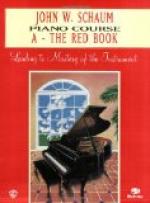“I make the same answer to this question that I made to the first—none. I never work for velocity, nor do I work up velocity. That is a matter that generally takes care of itself. If you know the piece absolutely, know what it means and the effects you want to make, there will be little difficulty in getting over the keys at the tempo required. Of course this does not apply to the pupil who is playing wrong, with weak fingers, uncertain touch and all the rest of the accompanying faults. I grant that these faults may not be so apparent in a piece of slow tempo. A pupil may be able to get through Handel’s Largo, for instance; though his fingers are uncertain he can make the theme sound half-way respectable, while a piece in rapid tempo will be quite beyond him. The faults were in the Largo just the same, but they did not show. Rapid music reveals them at once. Certain composers require almost a perfect technical equipment in order to render their music with adequate effect. Mozart is one of these. Much of his music looks simple, and is really quite easy to read; but to play it as it should be played is another thing entirely. I seldom give Mozart to my pupils. Those endless scales, arpeggios and passages, which must be flawless, in which you dare not blur or miss a single note! To play this music with just the right spirit, you must put yourself en rapport with the epoch in which it was written—the era of crinoline, powdered wigs, snuffboxes and mincing minuets. I don’t mean to say Mozart’s music is not emotional; it is filled with it, but it is not the emotion of to-day, but of yesterday, of more than a century back.
“For myself, I love Mozart’s music. One of my greatest successes was in a Mozart concerto with the Chicago Orchestra. I afterward remarked to one of my colleagues that it had been one of the most difficult tasks I had ever accomplished. ‘Yes, when one plays Mozart one is so exposed,’ was his clever rejoinder.”
(7) How do you keep repertoire in repair?
“If you mean my own, I would answer that I don’t try to keep all my pieces up, for I have hundreds and hundreds of them, and I must always save time to study new works. A certain number are always kept in practise, different programs, according to the requirements of the hour. My method of practise is to play slowly through the piece, carefully noting the spots that are weak and need special treatment. To these I give a certain number of repetitions, and then repeat the whole to see if the weak places are equal in smoothness to the rest. If not, they must have more study. But always slow practise. Only occasionally do I go through the piece at the required velocity.
“My pupils are always counseled to practise slowly. If they bring the piece for a first hearing, it must be slowly and carefully played; if for a second or third hearing, and they know it well enough to take it up to time, they can play it occasionally at this tempo before coming to me. But to constantly play a piece in rapid tempo is very harmful; it precludes all thought of analysis, of how you are doing it. When you are playing at concert speed, you have no time to think of fingering, movement or condition—you are beyond all that. It is only in slow practise that you have time and opportunity to think of everything.




